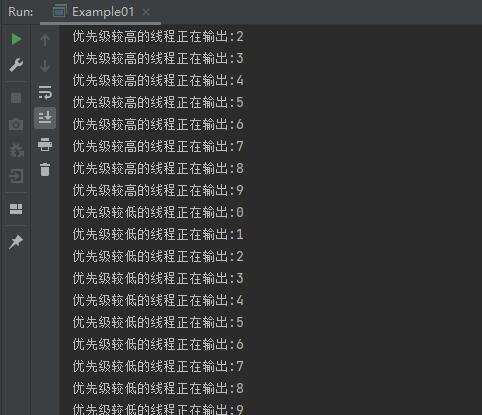Java线程优先级:Thread类的优先级常量
更新时间:2021年11月10日13时52分 来源:传智教育 浏览次数:

在应用程序中,如果要对线程进行调度,最直接的方式就是设置线程的优先级。优先级越高的线程获得CPU执行的机会越大,而优先级越低的线程获得CPU执行的机会越小。线程的优先级用1~10的整数来表示,数字越大优先级越高。除了可以直接使用数字表示线程的优先级外,还可以使用Thread类中提供的3个静态常量表示线程的优先级,如下所示。
| Thread类的静态常量 | 功能描述 |
|---|---|
| static int MAX_PRIORITY | 表示线程的最高优先级,值为10 |
| static int MIN_PRIORITY | 表示线程的最低优先级,值为1 |
| static int NORM_PRIORITY | 表示线程的普通优先级,值为5 |
程序在运行期间,处于就绪状态的每个线程都有自己的优先级,例如,main线程具有普通优先级。然而线程优先级不是固定不变的,可以通过Thread类的setPriority(int newPriority)方法进行设置,setPriority()方法中的参数newPriority接收的是1~10的整数或者Thread类的3个静态常量。下面通过一个案例演示不同优先级的两个线程在程序中的运行情况,如下所示。
// 定义类MaxPriority实现Runnable接口
class MaxPriority implements Runnable{
public void run(){
for (int i=0;i<10;i++){
System.out.println(Thread.currentThread().getName() +"正在输出:"+i);
}
}
}
// 定义类MinPriority实现Runnable接口
class MinPriority implements Runnable {
public void run(){
for(int i =0; i<10; i++){
System.out.println(Thread.currentThread().getName() +"正在输出:"+i);
}
}
}
public class Example01{
public static void main (String[] args){
// 创建两个线程
Thread minPriority = new Thread (new MinPriority(), "优先级较低的线程");
Thread maxPriority = new Thread(new MaxPriority(),"优先级较高的线程");
minPriority.setPriority (Thread.MIN_PRIORITY); //设置线程的优先级为1
maxPriority.setPriority (Thread.MAX_PRIORITY); //设置线程的优先级为10
//开启两个线程
maxPriority.start();
minPriority.start();
}
}
下面代码的运行结果如下图所示。

第2~8行代码定义了MaxPriority类并实现了Runnable接口,第10~16行代码定义实现了Runnable接口的MinPriority类,并在MaxPriority类与MinPriority类中使用for循环打印正在发售的票数,在第22行代码中使用MIN_PRIORITY方法设置minPriority线程的优先级为1,在第23行代码中使用MAX_PRIORITY方法设置manPriority线程优先级为10。
从运行结果可以看出,优先级较高的maxPriority线程先运行,运行完毕后优先级较低的minPriority线程才开始运行。所以优先级越高的线程获取CPU切换时间片的概率就越大。
猜你喜欢


















 AI智能应用开发(Java)
AI智能应用开发(Java) 鸿蒙应用开发
鸿蒙应用开发 HTML&JS+前端
HTML&JS+前端 Python+大数据开发
Python+大数据开发 人工智能开发
人工智能开发 跨境电商
跨境电商 电商视觉设计
电商视觉设计 软件测试
软件测试 新媒体+短视频
新媒体+短视频 集成电路应用开发
集成电路应用开发 C/C++
C/C++ 狂野架构师
狂野架构师 IP短视频
IP短视频





















